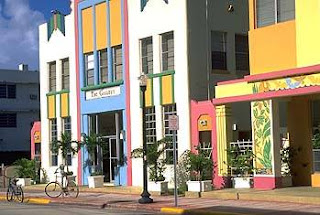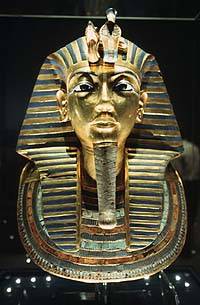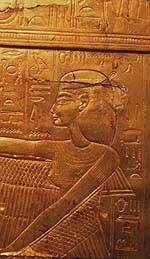The Dawn of Deco: History of Art Deco Architecture
These were the buildings of the future: sleek, geometric, dramatic. With their cubic forms and zigzag designs, art deco buildings embraced the machine age. Yet many features of the style were drawn not from the Jetsons, but the Flintstones.
 |
| Art Deco buildings in Miami, Florida |
During the roaring twenties and the early thirties, jazzy Art Deco architecture was the rage. Like any style, it evolved from many sources. The austere shapes of the Bauhaus School and streamlined styling of modern technology combined with patterns and icons taken from the Far East, ancient Greece and Rome, Africa, India, and Mayan and Aztec cultures. But most of all, Art Deco expressed excitement over a stunning archeological find in Egypt.
Echoes from the Tomb: Art Deco Architecture
 |
| King Tutankhamen |
In 1922, archaeologist Howard Carter and his sponsor, Lord Carnarvon, thrilled the world with their discovery of the tomb of King Tutankhamen. Reporters and tourists thronged the site for a glimpse at treasures which had laid nearly undisturbed for over 3,000 years. Soon a fascination for Ancient Egypt found expression in clothing, jewelry, furniture, graphic design and -- of course -- architecture.
The term Art Deco was coined from the Exposition des Arts Decoratifs held in Paris in 1925. Robert Mallet-Stevens (1886-1945) helped promote Art Deco architecture in Europe. In the United States, Art Deco was embraced by Raymond Hood, who designed three of the most distinctive buildings in New York City: the Radio City Music Hall auditorium and foyer, the RCA building at Rockefeller Center, and the New York Daily News building.
Symbolic Designs: Art Deco Architecture
 |
| From the Tomb of King Tutankhamen |
Ancient Egyptian art told stories. Highly stylized icons had symbolic meanings. Notice the images embossed into this wall from the tomb of King Tutankhamen.
Art Deco architects often lavished their buildings with symbolic images. Perhaps the most famous example is New York's Chrysler Building, designed by William Van Alen. Briefly the world's tallest building, the skyscraper is adorned with eagle hood ornaments, hubcaps and abstract images of cars. Other Art Deco architects used stylized flowers, sunbursts, birds and machine gears.
Patterns and Designs: Art Deco Architecture
 |
| Art Deco in Miami, Florida |
From skyscrapers and movie houses to gas stations and private homes, the idea of using icons in architecture became the height of fashion. Renown for its Moderne Deco architecture, the streets of of Miami, Florida are lined with buildings like the one shown here. The terra-cotta facing and the strong vertical bands are typical Art Deco features borrowed from antiquity. Other characteristics of the style include zigzag designs, echoing patterns and vivid colors that would delight the slumbering Egyptian king.
King Tut Goes Mod: Art Deco Decoration
 |
| The Art Deco Empire State Building in New York City |
When Howard Carter opened the tomb of the ancient Egyptian king, Tutankhamen, the world was dazzled by the brilliance of the treasure.
Vivid color, strong lines and undulating, repeating patterns are a trademark of Art Deco design, especially in the Moderne Deco buildings of the 1930s. Some buildings are embellished with flowing waterfall effects. Others present colors in bold, geometric blocks.
But, Art Deco design is about more than color and ornamental patterns. The very shape of these buildings expresses a fascination for orderly forms and primitive architecture. The early Art Deco skyscrapers suggest Egyptian or Assyrian pyramids with terraced steps rising to the top.
Built in 1931, the Empire State Building in New York City is an example of tiered, or stepped, design.
Steps in Time: Art Deco Ziggurats
Skyscrapers built during the 1920s and early 1930s may not have the brilliant colors or zigzag designs we associate with the Art Deco style. However, these buildings often took on a distinctive Art Deco shape: The ziggurat.
 |
Art Deco ziggurats form the Louisiana State Capitol |
A ziggurat is a terraced pyramid with each story smaller than the one below it. Art Deco skyscrapers may have complex groupings of rectangles or trapezoids. Sometimes two contrasting materials are used to create subtle bands of color, a strong sense of line, or the illusion of pillars. The logical progression of steps and the rhythmical repetition of shapes suggest ancient architecture, yet also celebrate a new, technological era.
Art Deco is an eclectic style -- a conglomeration of influences from many cultures and historic periods. It's easy to overlook the Egyptian elements in the design of a posh theater or a streamlined diner. But the tomblike shape of twentieth century "ziggurats" make it clear that the world was in a tizzy over King Tut.
0 komentar:
Post a Comment
comment HERE